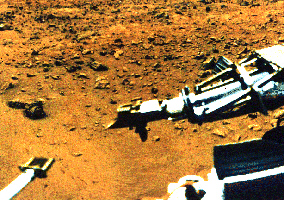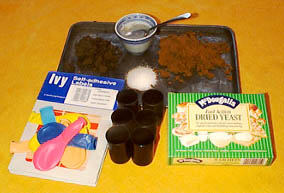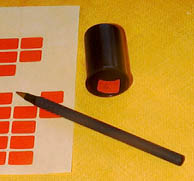




Alien
Soil Cultures
A lesson in making the wrong scientific assumptions
|
Most school experiment are designed to demonstrate a particular scientific principle. They have been done many, many times and they are nearly always made to work, (even if your teacher helps you cheat!). Science in the real world is not like this, however. Scientists work at the very edge of knowledge and they often probe into the unknown. This is what science is all about and what makes it exciting. Sometimes of course, scientists get it wrong. They make incorrect assumptions, and if the errors are not detected this can lead to all sorts of problems. Here we can do an experiment, which on the face of it looks simple and straightforward, though the assumptions are wrong. If you take the results at face value, they could be interpreted that there is no life on Earth! The experiment demonstrates how things can go wrong, and how careful you need to be in drawing conclusions from an experiment.
Background
|
|

Back in 1976, when the Viking spacecraft landed on Mars, one of the tests that was carried out was to detect gas given off by any martian microbes that might be lurking in the soil - the Gas Exchange Experiment. Similar tests could be conducted on Earth to see if life can be found here! The Viking life tests caused a lot of problems in their interpretation. At first, the results appeared to be positive, but then doubts appeared and arguments about the results have continued ever since. The generally accepted view is that life was not detected. False readings caused by normal chemical - non-organic - processes gave the positive readings. However there are some notable people who still dispute this, and claim the readings were due to life processes. You can undertake a simplified simulation of the test using everyday products. You should get positive life results where there IS life. You may also get negative reading where there IS life and we will show you how positive readings can be obtained where there is NO life. On Earth we would be able to carry out other tests to help confirm the result, but when conducting such tests at a distance of several million miles, by remote control, it can be difficult. You cannot change anything or try new tests that you might have devised. |
|
Your task is to find out which of 5 soil samples contains living organisms by detecting the gas given off by their metabolism. Upon getting the results you should re-evaluate the experimental assumptions to see if they are valid. Then devise further experiments to test the assumptions. Be critical. From your own knowledge, do the results make sense? Are they reasonable? Could there be other explanations for the results? Did you get negative results where you expected positive ones? If you got positive results, are you sure they are life signs and not from a non-biological process? To help in this read up on the subject. Assumptions
Hygiene
Experiment
Design |

|
|
How to proceed 1 Collect half a cup of some soil from the your yard, garden or a field. Try and ensure it contains some decaying matter (eg leaves). 2 Use the film containers as the sealed environment incubation chambers. You will only need about two teaspoons of each soil sample in each container. You do not need to fill the film pots! 3 Prepare your five soil samples as follows:
|
|

4 Label your pots on the inside, so you will not know which pot is which when you put the balloons on. However you should record the soil and nutrient contents of each for later reference. 5 Put each sample into a canister, recording which container contains which sample 6 Prepare nutrient by dissolving two teaspoon of sugar in half a cup of warm water. Allow this to cool. 7 Add a teaspoon of nutrient to:
8
Record which container has nutrient added. 9
Place a balloon on each container, so it can inflate
a little as gas is given off. Ensure the balloon is absolutely
flat and uninflated as you do this, so it flops over the side
of the container.
11 Leave the samples at room temperature for at least half an hour (you can leave the samples for several days if you wish). 12
Now inspect what has happened? (If nothing has happened wait at
least four hours) 13 Using the amount of inflation as your guide, write down which sample you think is which. Also record which and approximately by how much, each balloon has inflated. 14 Now remove the balloons and see if you predictions are correct. 15 You may well have discovered that only one balloon has inflated - the one with "Mars" soil and nutrient. Now, three others had living material in them. The exception being the (sterile) sand. So why no balloon inflation? Maybe it was the lack of nutrient. But nutrient was added to an Earth soil sample too. So why was there no inflation? Can we conclude there is no life on Earth? No, of course not. But we can conclude that there was no life in our particular soil sample. Can't we? |
|
|
No! If you inspect it visually, you may be able to see living things in it, with the naked eye - algae, worms or mites for instance. Under a microscope you can probably see more living organisms. In fact, it is likely that the sample is full of life. So why did our test fail? |
|

16 Before we look into that, lets do a little test with the last film canister. 17 Take the final film canister and add half a tea spoon of baking powder. The next part will have to be done very quickly. You may want someone to help you. Take a teaspoon of vinegar and add it to the film pot. Now fit the balloon over the top, very quickly. Does the balloon inflate? Is this the sign of life we were looking for? Is the mixture alive? 18 Your balloon should have inflated, at least a little. Yes, balloon inflation is the life sign we were looking for. But no, the mixture is not alive. The gas given off, which is carbon dioxide and the same as that produced by the yeast in the "mars" soil sample, is made by a normal chemical reaction, not by living entities. |
|
|
19 We must therefore conclude, that although the chemicals and materials in each experiment were totally different the result was the same. If we accept our initial assumption, then not only do living things appear not to be alive, there are circumstances where non-living materials DO appear to be alive. Our assumptions must be wrong. Totally wrong. There are two main flaws in our assumptions. Flaws in the assumptions and what should be concluded
Our example here was very simple, and the flaws were easily found when a little thought and book research was applied to the problem. But for the Mars Mission designers in 1974, when the Viking mission was being planned, the situation was different. There were no books to check and the true composition of Mars soil was only guessed at . They
built four test experiments that could cross check each other,
and there was a video camera for visual inspection. The
Viking mission specialists did the best they could with the available
data, both before and after the mission. You can only hope
to do the same. But be aware that on occasions your assumptions
at the beginning of your experiment could be wrong. This
is often how new scientific breakthroughs come about. |
![]()
Microbiology
Teachers' Notes for
Experiments
Thursday's
Classroom - Planets in a Bottle
Viking Experiments
Life on Mars
Life on other planets
Go
to
Home
| Space Station
| Mars | Rainforest
© 1999 Satellite Events Enterprises Inc.

